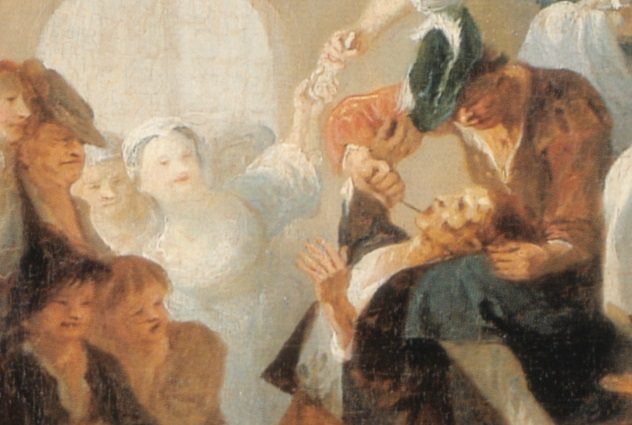 Miscellaneous
Miscellaneous  Miscellaneous
Miscellaneous  Gaming
Gaming 10 Funny Tutorials in Games
 History
History 10 Fascinating Little-Known Events in Mexican History
 Facts
Facts 10 Things You May Not Know about the Statue of Liberty
 Movies and TV
Movies and TV 10 Movie Adaptions That Brought Popular Songs to Life
 Health
Health 10 Miraculous Advances Toward Curing Incurable Diseases
 Miscellaneous
Miscellaneous 10 Undeniable Signs That People’s Views of Mushrooms Are Changing
 Animals
Animals 10 Strange Attempts to Smuggle Animals
 Travel
Travel 10 Natural Rock Formations That Will Make You Do a Double Take
 Movies and TV
Movies and TV 10 Actors Hidden in Your Favorite Movies
 Miscellaneous
Miscellaneous 10 Interesting Things Manufacturers Stopped Making and Why
 Gaming
Gaming 10 Funny Tutorials in Games
 History
History 10 Fascinating Little-Known Events in Mexican History
Who's Behind Listverse?

Jamie Frater
Head Editor
Jamie founded Listverse due to an insatiable desire to share fascinating, obscure, and bizarre facts. He has been a guest speaker on numerous national radio and television stations and is a five time published author.
More About Us Facts
Facts 10 Things You May Not Know about the Statue of Liberty
 Movies and TV
Movies and TV 10 Movie Adaptions That Brought Popular Songs to Life
 Health
Health 10 Miraculous Advances Toward Curing Incurable Diseases
 Miscellaneous
Miscellaneous 10 Undeniable Signs That People’s Views of Mushrooms Are Changing
 Animals
Animals 10 Strange Attempts to Smuggle Animals
 Travel
Travel 10 Natural Rock Formations That Will Make You Do a Double Take
 Movies and TV
Movies and TV 10 Actors Hidden in Your Favorite Movies
10 Things That Were Common In The Past That We Couldn’t Imagine Now
We can all agree that our way of life has changed in some pretty astonishing ways over the years. Technological breakthroughs and our understanding of the human mind and body have led the way in making great strides in our modern world.
Our ancient ancestors would undoubtedly have a hard time believing what mankind has been able to accomplish. We’ve traveled to the Moon, launched satellites into space, landed rovers on distant planets, and manned the International Space Station. The medical community has accomplished things that many would have thought impossible in years past, such as curing and managing disease, intricate transplant operations that save lives, and developing medications that treat illnesses to give humans a better quality of life.
The thing is, we might have just as hard of a time believing what was normal for our ancestors. Let us explore a few of the things that used to be commonplace but that we could not imagine doing today.
10 Legal Drug Use

400,000 soldiers were said to be addicted to opiates during the US Civil War. As bizarre as it may sound today, it was widely believed that addiction wouldn’t occur if they injected the drugs directly into the vein, because they wouldn’t reach the stomach.
Dating back to early times, many mood-altering drugs were easily available with or without a doctor’s prescription. As women were deemed the “weaker sex,” they were prescribed these drugs abundantly for a wide variety of “ailments.” There is little wonder that women were reported to be addicted to these drugs at three times the rate of men.
Some of the more outlandish women’s “conditions” that these drugs were used for included sexual exhaustion, ticklishness, cracked nipples, boredom, homesickness, hysteria, and vomiting from pregnancy. It was also common for women to get cocaine injections to make them more “lively and talkative” and to hold “oxygen parties” to inhale nitrous oxide.[1]
9 Being Operated On By Your Barber

In need of a shave and a haircut? Been meaning to have that pesky toe amputated because it’s been bothering you? No problem, get them all taken care of at the local barber-surgeon’s shop.[2] You can be sure you’re in the right place if you see a fresh bowl of blood sitting in the window or a red and white striped pole outside the door. The red on the pole means blood, and the white means bandages.
Early medical treatments could be scary stuff. Bloodletting was an especially popular service that barber-surgeons offered. Veins were opened up to drain the blood, or leeches could be applied to do the job. Unfortunately, the “surgeons” didn’t always know when to stop, so the patient sometimes lost way too much blood. Trepanning was also rather popular. This would entail drilling a hole in the head to serve as treatment for things such as headaches, abscesses, dementia, mental illnesses, and treatment for head wounds. It was also used to let out evil spirits. Worst of all, you would more than likely be awake during this treatment, and there was no anesthesia. And last but not least: amputations. By your barber. Do we really need to say anything more?
Early on, the causes of illnesses and the reasons for the spreading of disease were unknown. At times, it was not unusual to blame sickness on things such as demons, the stars, sin, witches, and even bad smells.
8 Capital Punishment As Entertainment

Public executions during medieval times were carried out in front of large crowds of spectators to demonstrate that crime would not be tolerated. Rumor has it that public holidays were often declared as a way to increase attendance, and the atmosphere was often charged with excitement.
Hanging was one of the most common methods of execution, so much so that most towns and villages had permanent gibbets erected in a central location. Once the criminal was executed, the body would sometimes be removed immediately but other times would be left in the gibbet until the corpse pretty much turned to dust.
Decapitation was another popular form of capital punishment, especially for noblemen and noblewomen. If you were lucky, the executioner would get the job done on the first try. If his ax or sword was dull, or he was just careless, it could take multiple strikes to achieve the desired goal. Reportedly, a convicted countess received ten blows before the fatal strike. Decapitated heads were sometimes known to be impaled on stakes and displayed indefinitely, to serve as a reminder that law and order would prevail in that particular town.[3]
7 Grave Robbing In The Name Of Science

It has long been a tradition to provide a beautiful and moving funeral ceremony to honor the lives of loved ones who have gone before us. We grieve, we share memories, and then we lay them to rest so that they may be at peace. Unfortunately, in Renaissance times, it was possible that some of the dearly departed may not have rested in peace after all.
As science and medicine progressed, it was determined that knowledge of human anatomy would be very beneficial to mankind. Due to that thirst to understand where things were and how they worked in the human body, there was soon a shortage of cadavers to dissect. Initially, the main source of bodies came from executed criminals. When demand exceeded supply, body snatchers came in.
They would dig up a large number of bodies under cover of darkness, the night after they were buried. These corpses would then be sold to anatomists to dissect while they were still somewhat fresh. When the grave robbers couldn’t keep up with demand, medical students would sometimes take the cadavers themselves. Some were even caught and convicted for it. In the most desperate of times, corpses were hijacked from funeral processions.
As a side note, Leonardo da Vinci was known to have dissected many cadavers. He made a number of important discoveries and was able to produce extremely detailed drawings that greatly enhanced the education of medical students.[4]
6 Challenging Someone To A Duel

The gauntlet (or glove) has been thrown. The words have been uttered: “I challenge you to a duel.” The challenged has signified his acceptance by picking up the gauntlet. All that is left to do is determine the time, place, and weapon of choice. Early on, those choices would have been some type of sword, then the rapier as fencing became popular, and later the pistol.
The duel was a popular way for refined, sophisticated gentlemen to defend their honor and reputation for centuries.[5] The insults that brought on the contest were frequently trivial. It could have been for something as ridiculous as saying you didn’t like someone’s clothing. Strict rules were in place to try to prevent the death of the participants, but they weren’t always successful.
In ancient times, judges were known to order two individuals to participate in a judicial duel, or trial by battle, as a way to settle their disputes.
5 Extremely Slow, Dangerous Travel

Getting from point A to point B was quite a challenging task in medieval times. It’s hard to imagine the difficulties that were faced when traveling. In modern society, there are a number of options at our disposal, but in those days, the choices were very limited. Traveling by foot would be one option. This would let you cover approximately 24 to 40 kilometers (15–25 mi) a day. Another option would be travel by horse. This would be a little better, at 32 to 48 kilometers (20–30 mi) a day. Sailing, if possible, would be quite a bit faster at 120 to 200 kilometers (75–125 mi) a day.
The length of the journey wouldn’t be the only problem. If there was no inn or other safe place to take refuge for the night, travelers would often have to sleep outside in the elements. Food and drink could run out or spoil, accidents or illness could occur, and there was always the worry of robbery or worse. Sailing would have been dangerous as well. Many of the wooden ships would not have been able to withstand the pummeling of dangerous storms.[6]
4 Brutal Punishment For Committing Adultery

The Scarlet Letter, a novel written by Nathaniel Hawthorne, chronicles the story of a Puritan woman whose husband had gone missing. Horror of horrors, she ended up pregnant. She was thrown in jail, where she gave birth. Upon her release, she was forced to wear a scarlet “A” on her clothing for the rest of her life. She was also shunned by the community.
We’d like to think that something like this didn’t happen in reality. Unfortunately, it did. A Puritan woman who cheated on her husband was sentenced to be whipped in public. After enduring a whipping in her own community, she was then taken to the town where the adultery took place. While there, she received a second whipping. Since that wasn’t humiliating enough, she was forced to wear the letters “AD” on her clothing so that everyone knew she was an adulteress. Just like in The Scarlet Letter.
Women would also be punished by being driven through town in a cart while being whipped. Some were actually executed for their “crime.” Notice these punishments were all for women. When a man committed adultery, he was charged with the lesser crime of fornication. Women were charged with the more serious crime of adultery because they were considered to be temptresses.[7]
3 All In The Name Of Beauty

What we consider beautiful and fashionable changes greatly with the passage of time. In the mid-1400s, high society ladies were considered beautiful if they had high, dome-like foreheads and milky white skin. In order to accomplish this look, they would pluck out the hair at the hairline so that their foreheads looked bigger. If plucking didn’t bring the desired results, they would rub the area with a rough stone or burn the hair off with a chemical. They also tended to pluck their eyelashes and most of their eyebrows.
Suntans were only for peasant women, so the wealthy would do everything they could to achieve a pale, white complexion. Cosmetics made of mercury, pearls, silver, or egg shells would sometimes be used on the face. Others may have used things like white flour, chalk, or white lead powder, which would be mixed with olive oil. To make the cosmetics last longer, they may have applied a thin layer of egg white to the face.[8]
2 To Bathe Or Not To Bathe

During the Middle Ages, people tended to bathe more frequently than they would in Renaissance times. But then, for some bizarre reason, physicians started to believe that bathing in water would make you more susceptible to catching diseases. Some also thought that opening up the pores during bathing would allow a person’s “vital forces” to escape the body.
Of course, people during the Renaissance still wanted to be clean and presentable. Especially in high society. Some would use hand basins in their homes, where they could cleanse their hands and faces with water throughout the day. Others would sprinkle their clothing with heavy perfumes, and some would use scented towels that would be rubbed over the face and body. Last but not least, the key to cleanliness seemed to lie in frequently changing one’s linen undergarments.[9]
1 Excessive And Deadly Childbirth

A married woman’s biggest duty was to produce children during the Renaissance period. Even though many women died in childbirth, and the infant mortality rate was high, she would have gotten pregnant over and over again during her lifetime. As you can imagine, childbirth was the leading cause of death in young women. It was not unusual for one woman to give birth eight to 12 times. Some, as many as 20 or more. The sheer volume of births would greatly up the odds of problems arising, or even death.
The midwives who assisted in these births were educated only by the women of previous generations. They were able to handle everything from regular births to turning the baby if it was breeched to doing an emergency baptism if it looked like the baby might not survive. They could also remove stillborn babies from the mothers and could perform cesareans to save babies if the mothers passed during labor.[10]
Read about more ways the past was very different on Top 10 Crazy Ways Past Cultures Saw Human Sexuality and 10 Eerie Items of Clothing from the Past.








